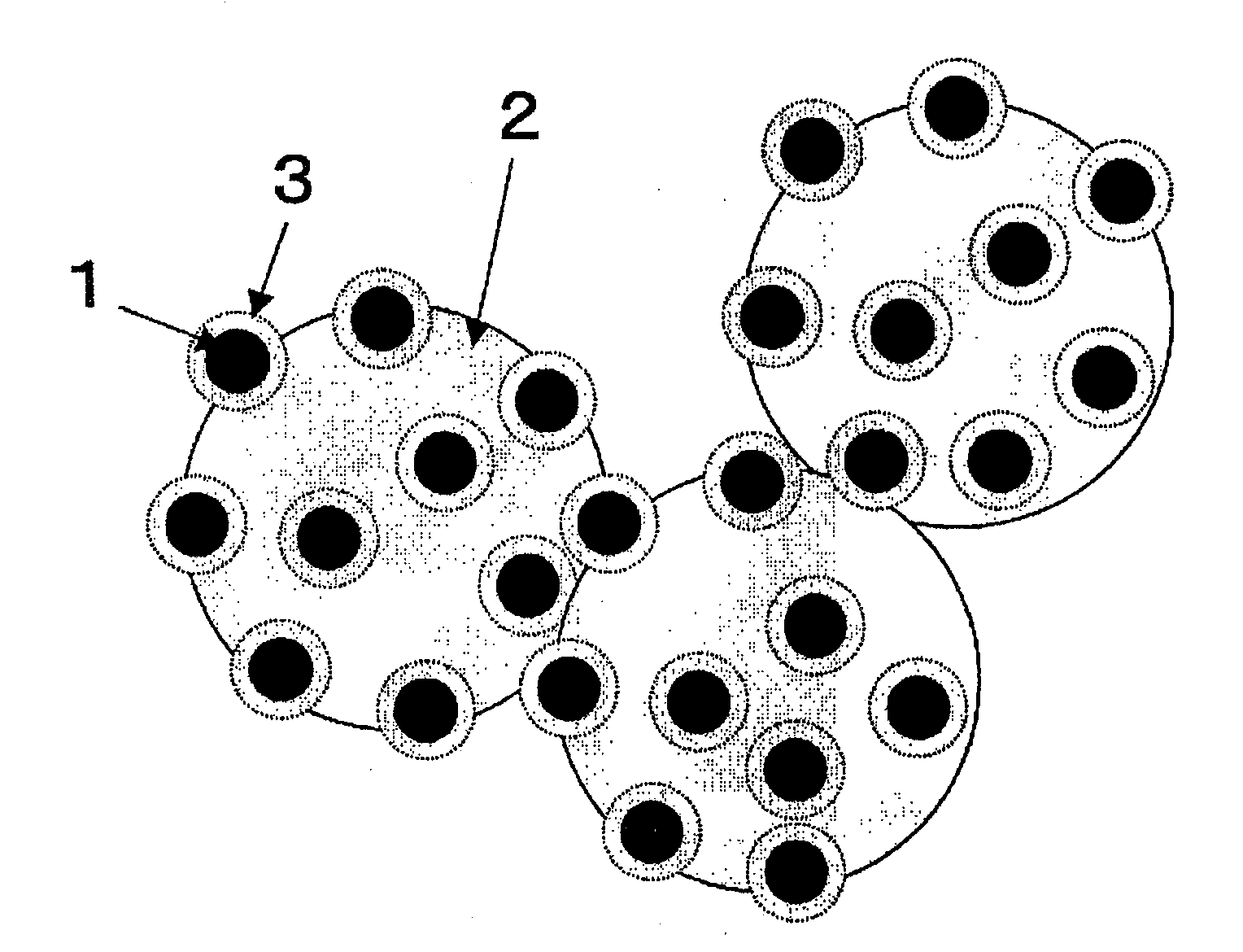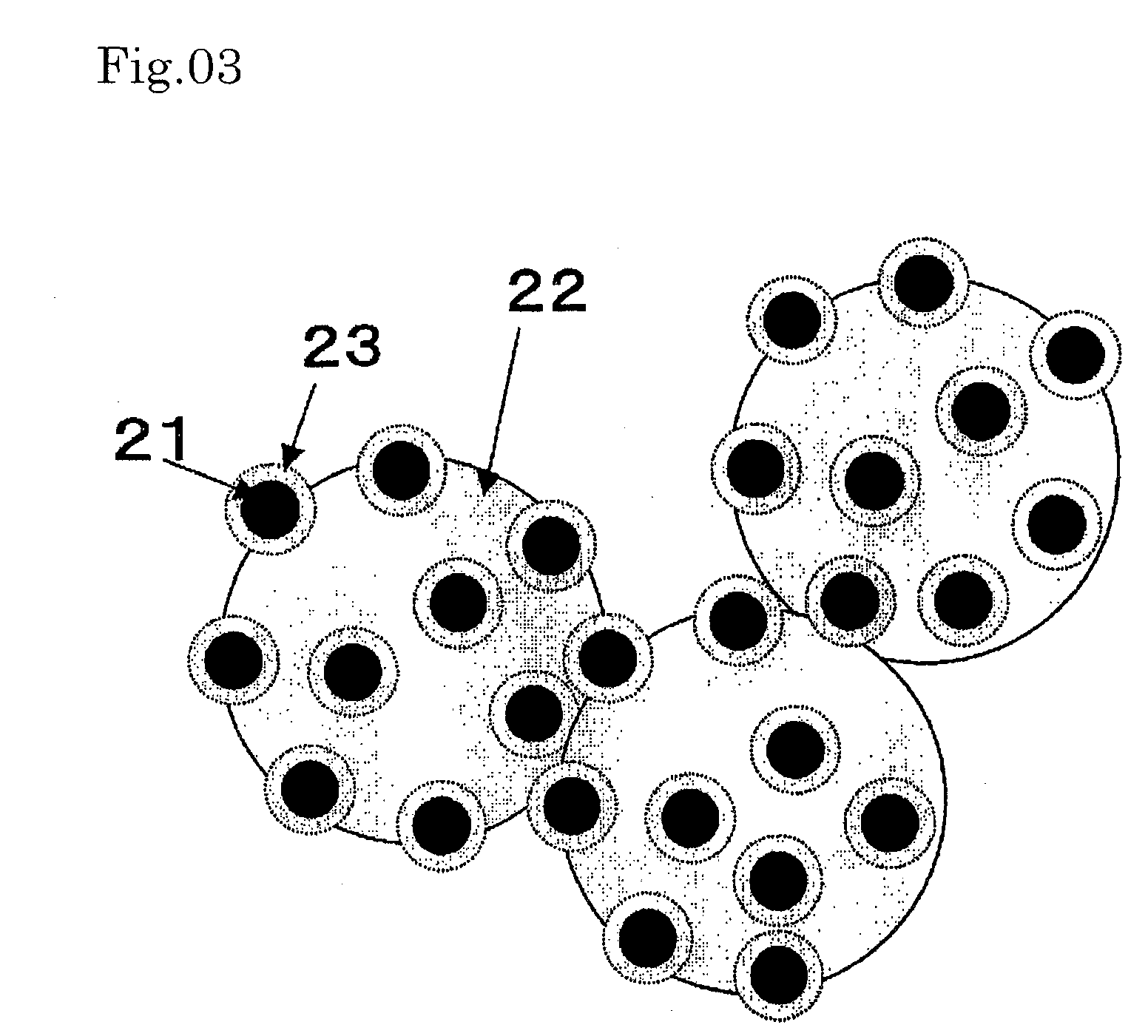Catalyst nanoparticle
a catalyst nanoparticle and surface modification technology, applied in the direction of metal/metal-oxide/metal-hydroxide catalysts, physical/chemical process catalysts, cell components, etc., can solve the problems of high cost of catalyst nanoparticles with a particle diameter of 2-3 nm, and high cost of metal-based catalysts. achieve the effect of reducing catalytic activity
- Summary
- Abstract
- Description
- Claims
- Application Information
AI Technical Summary
Benefits of technology
Problems solved by technology
Method used
Image
Examples
example 1
[0086]FIG. 1 is a schematic representation of a Pt—Ru alloy nanoparticle-carrying catalyst. The catalyst (catalyst Λ) shown in FIG. 1 was prepared in the following manner.
[0087] First, a colloidal solution of Pt—Ru alloy nanoparticles was prepared by adding an aqueous solution (33 mL) containing 128 mg of sodium borohydride (product of Wako Pure Chemical) dissolved therein to an aqueous solution (1967 mL) containing 63 mg of citric acid monohydrate (product of Wako Pure Chemical), 125 mg of chloroplatinic(IV) acid hexahydrate (product of Wako Pure Chemical) and 63 mg of ruthenium(III) chloride n-hydrate (product of Wako Pure Chemical) dissolved therein, and stirring the mixture for 1 day. It was confirmed by observation under a transmission electron microscope that the Pt—Ru alloy nanoparticles obtained had a particle diameter of about 2 nm, as described later herein.
[0088] Thereafter, an aqueous solution (250 μl) containing 0.842 μl of 3-aminopropyltrimethoxysilane (product of Al...
example 2
[0094]FIG. 3 is a schematic representation of a Pt nanoparticle-carrying catalyst. The catalyst shown in FIG. 3 (catalyst C) was produced in the following manner.
[0095] First, a colloidal solution of Pt nanoparticles was prepared by adding an aqueous solution (33 mL) containing 128 mg of sodium borohydride (product of Wako Pure Chemical) dissolved therein to an aqueous solution (1967 mL) containing 63 mg of citric acid monohydrate (product of Wako Pure Chemical) and 250 mg of chloroplatinic(IV) acid hexahydrate (product of Wako Pure Chemical) dissolved therein, and stirring the mixture for 1 day. Then, an aqueous solution (250 μl) containing 0.842 μl of 3-aminopropyltrimethoxysilane (product of Aldrich) dissolved therein was added. After 20 minutes, 80 mL of an aqueous solution of sodium silicate as adjusted to pH 10.5 was added, and the resulting mixture was stirred for 2 days to coat the nanoparticles with porous SiO2. To this solution was added an aqueous dispersion (20 mL) of 2...
PUM
| Property | Measurement | Unit |
|---|---|---|
| particle diameter | aaaaa | aaaaa |
| particle diameter | aaaaa | aaaaa |
| particle diameter | aaaaa | aaaaa |
Abstract
Description
Claims
Application Information
 Login to View More
Login to View More - R&D
- Intellectual Property
- Life Sciences
- Materials
- Tech Scout
- Unparalleled Data Quality
- Higher Quality Content
- 60% Fewer Hallucinations
Browse by: Latest US Patents, China's latest patents, Technical Efficacy Thesaurus, Application Domain, Technology Topic, Popular Technical Reports.
© 2025 PatSnap. All rights reserved.Legal|Privacy policy|Modern Slavery Act Transparency Statement|Sitemap|About US| Contact US: help@patsnap.com



